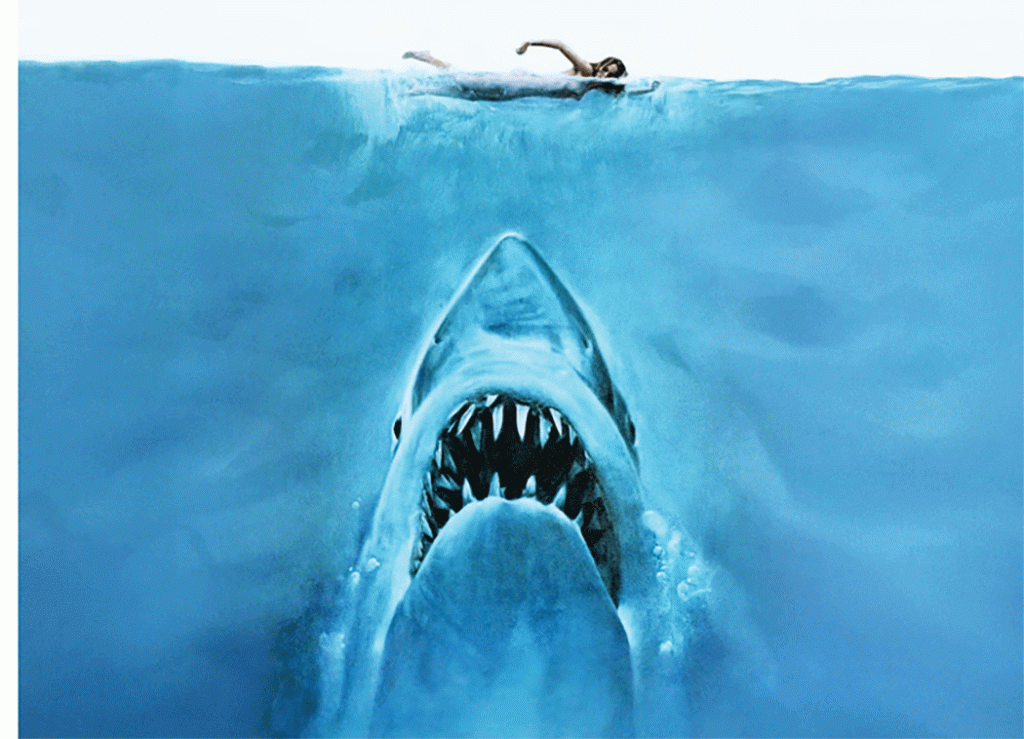 “There is no terror in the bang, only the anticipation of it.” —Alfred Hitchcock, whom Steven Spielberg studied to master suspense
“There is no terror in the bang, only the anticipation of it.” —Alfred Hitchcock, whom Steven Spielberg studied to master suspense
You’re gonna need a bigger boat.” This utterance from the 1975 mega-movie Jaws, starring Roy Scheider, Robert Shaw, and Richard Dreyfuss, became one of cinema’s most quotable lines. When Chief of Police Martin Brody (Scheider) gets a much-too-close encounter with the great white shark attacking swimmers at Amity Island beach, he alerts boat pilot Quint (Shaw) with this understatement, suggesting their vessel is too small to capture that shark. Guided by a wise director in one of the movie’s tensest moments, Brody delivered comic relief.
Jaws @ 50 is an entertaining, informative, and revealing documentary. It rewinds to the 1970s, when Peter Benchley’s novel Jaws, about a great white shark terrorizing a small resort community, was gaining fame. Benchley was a native of Nantucket, a little island east of Martha’s Vineyard, where Jaws was staged. Benchley was hired by United Artist producers Richard D. Zanuck and David Brown to draft a Jaws screenplay that omitted the book’s subplots, which distracted from the shark. The film story would then be a straight line from shark discovery to pursuit to capture. The end. Roll credits. Benchley’s script was followed by submissions from two more writers, Carl Gottlieb and Howard Sackler, all of whom are credited, along with the film’s director, Stephen Spielberg. And Benchley scored a film cameo as the Amity news reporter.
In 1975, on the day of the film’s release, Spielberg observed a movie theater showing Jaws with a ticket line extending around the block. The attendance seemed satisfying. But like the film’s characters comprehending the unfathomable size of the great white shark, Spielberg never anticipated how long that line would grow. Or that the film would break all box office records while frightening an entire nation of beach lovers from even parking near an ocean.
Near the shores of Amity Island, a.k.a. Martha’s Vineyard, we meet the much-anticipated shark, whose accompanying musical percussion resembles a beating heart in panic mode. The film is populated with local Vineyard residents in crowded beach scenes as well as in several small supporting roles, and one who coached Robert Shaw. The film team meshed with the friendly island community, except for the enforcement of strict laws that prohibited construction of temporary film sets. When the film was finally completed, Jaws premiered in the Vineyard’s local theater so the island residents could be among the first to view it.

Last, but never least . . . the director. In an ad for Jaws, Spielberg was “the man who frightened America.” And from the man himself, referring to Jaws: “The film I thought would end my career is the film that began it.” Yet in high school, he was the applicant that USC Film School rejected twice. Fast forward to age 26. With a resumé of three motion pictures, Spielberg campaigned Universal Studios to let him direct Jaws, which they did. Spielberg loved the book because it scared him. But he never imagined that the challenge of making the film would be even scarier.
Portrayed by three mechanical polyurethane models, the great white shark appears huge and realistic, and might have performed well if the designers had been allowed more time to make them saltwater-resistant. Instead, shark failures kept sending Spielberg back to the drawing board for work-around rewrites that minimized shark appearances. Remember those floating yellow barrels in Jaws that tracked the shark’s trajectory? That was a Spielberg innovation so the malfunctioning shark didn’t have to surface.
Jaws @ 50 allows Spielberg to describe the outdoor challenges that occurred every day in every scene—due to water, wind, waves, weather, currents, and tides—along with the three “sharks” that failed to function and the film-crew boat that had to readjust for every shift in the elements. Jaws was a nightmare to complete, and the studio heads took notice. But Spielberg would not abandon the project. His unflappable confidence must have convinced the visiting studio executive to let him continue. Meanwhile, the worn-out director needed space, time, and privacy to fall apart from the stress and frustration, but that would have to wait.
Commentaries about Spielberg’s films and talent come from filmmakers like J.J. Abrams, Guillermo del Toro, Jordan Peele, George Lucas, James Cameron, Robert Zemeckis, and Cameron Crowe. In his Jaws book intro, Benchley calls Spielberg a 26-year-old genius. And in this documentary, author Jeffrey A. Kramer explains Spielberg’s gift as “the ability to make things work when nothing is working.”
When Jaws was first released, I was curious but afraid to see it. I finally watched it a few years ago at my husband’s insistence, and he promised to join me. I loved the film, and I celebrated the anniversary by watching it again recently, along with this incredible documentary. Jaws @ 50 is an education, an introduction to filmmaking that makes us appreciate everything we see on the screen. While watching a movie, if we’re not thinking about the work behind the scenes that brought everything together, the director has succeeded. Just like Steven Spielberg, who fought a long, huge battle offscreen, and won. And we thought this was just about a great white shark.
